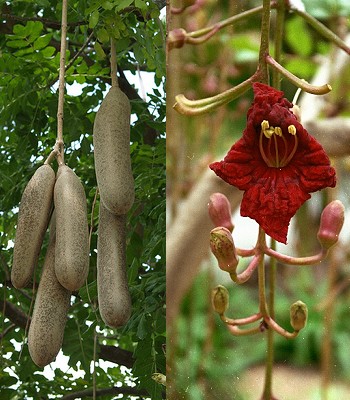
|
|
Sausage Tree
- Kigelia pinnata
|
Sausage Tree - Kigelia pinnata
Kigelia is a genus of flowering plants in the family Bignoniaceae. The genus comprises only one species, Kigelia africana
(Kigelia pinnata), which occurs throughout tropical Africa from Eritrea and Chad south to northern South Africa, and west to Senegal and Namibia.
The genus name comes from the Mozambican Bantu name, kigeli-keia, while the
common name Sausage Tree refers to the long, sausage-like fruit. Its name in Afrikaans Worsboom also means Sausage Tree, and its Arabic name means "the father of kit bags" (Roodt 1992).
It is a tree growing up to 20 m tall. The bark is grey and smooth at first, peeling on older trees. It can be as thick as 6 mm on a 15-cm branch (Roodt 1992). The wood is pale brown or yellowish, undifferentiated and not prone to cracking (Roodt 1992).
The tree is evergreen where rainfall occurs throughout the year, but deciduous where there is a long dry season. The leaves are opposite or in whorls of three, 30–50 cm long, pinnate, with six to ten oval leaflets up to 20 cm long and 6 cm broad; the terminal leaflet can be either present or absent. The flowers (and later the fruit) hang down from branches on long flexible stems (2-6 metres long). Flowers are produced in panicles; they are bell-shaped (similar to those of the african tulip tree but darker and more waxy), orange to reddish or purplish green, and about 10 cm wide. Individual flowers do not hang down but are oriented horizontally. Some birds are attracted to these flowers and the strong stems of each flower make ideal footholds. Their scent is most notable at night indicating their reliance on pollination by bats, which visit them for pollination and nectar.
The fruit is a woody berry from 30–100 cm long and up to 18 cm broad; it weighs between 5–10 kg, and hang down on long, rope-like peduncles. The fruit pulp is fibrous and pulpy, and contains numerous seeds. It is eaten by several species of mammals, including Baboons, Bushpigs, Savannah Elephants, Giraffes, Hippopotami, monkeys, and porcupines. The seeds are dispersed in their dung. The seeds are also eaten by Brown Parrots and Brown-headed Parrots, and the foliage by elephants and Greater Kudu (Joffe 2003; del Hoyo et al. 1997). Introduced specimens in Australian parks are very popular with cockatoos.
The sausage tree has a long history of use by rural African communities, particularly for its medicinal
properties. These properties are found in every part of the tree, including the
fruit, the bark, the roots and the leaves. Most commonly, traditional healers have used the sausage tree to treat a wide range of skin
ailments, from relatively mild complaints, such as fungal infections, boils, psoriasis and
eczema, rheumatism, snakebites, evil spirits, through to the more serious
diseases, like leprosy, syphilis and skin cancer. Several internal applications have also been
employed, including treatment of dysentery, ringworm, tapeworm, post-partum
haemorrhaging, malaria, diabetes, pneumonia and toothache. Perhaps not surprisingly
(given the suggestive shape of its fruit), it is also used as an aphrodisiac.
In the arid regions of West Africa, Kigelia africana, a particularly productive
tree, is noted in numerous beliefs for its large woody fruits which look like enormous bags hanging from the end of long
stalks: it is the perfect fertility image. Women nursing children hang strips of fabric on it to ask for protection and numerous
offspring. The popular subconscious has translated the tree’s exuberant image of fertility and the appearance of its
fruits, which resemble male organs, into supernatural faculties beneficial to
procreation.
An alcoholic beverage similar to beer is also made from the fruit. The fresh fruit is poisonous and strongly purgative; fruit are prepared for consumption by drying, roasting or fermentation (Joffe 2003; McBurney 2004). In Botswana the timber is used for makoros, yokes and oars (Roodt 1992). Kigelia is also used in a number of skin care
products. A related use for the fruit is as a cosmetic
cream. The Tonga women of the Zambezi valley, for example, regularly apply preparations of the Sausage fruit to their
faces, to ensure a blemish-free complexion.
The tree is widely grown as an ornamental tree in tropical regions for its decorative flowers and unusual fruit. Planting sites should be selected carefully, as the falling fruit can cause serious injury to people, and damage vehicles parked under the trees.
Source:
http://en.wikipedia.org/wiki/Kigelia
http://www.sos-arsenic.net/english/environment/kigelitree.html
